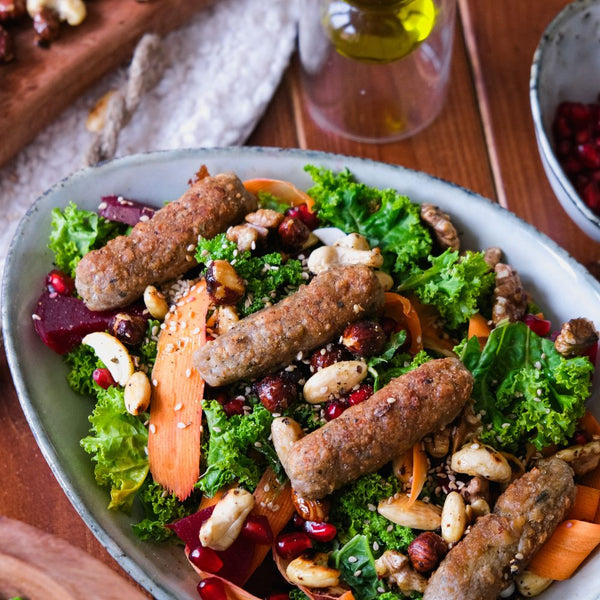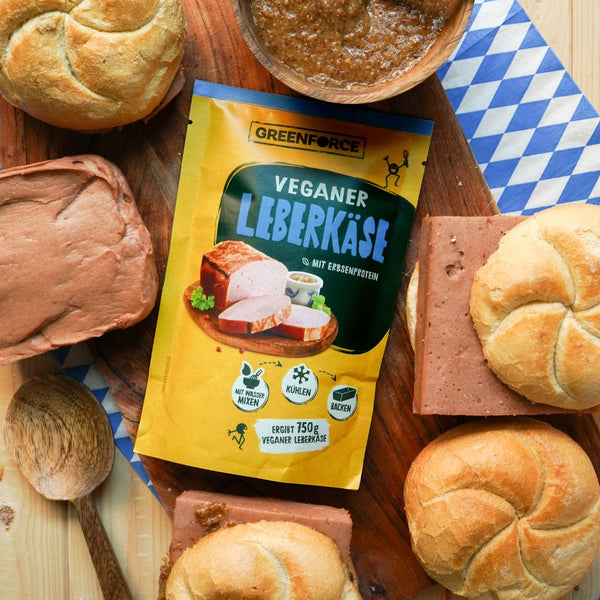Anyone who has committed themselves to veganism has to give up numerous “normal” foods. The menu quickly becomes full of “substitutes” and “alternatives” to avoid animal products.
If you now ask yourself : “ What exactly do vegans eat?” In this guide we would like to show you how this type of nutrition works and what options you have.
These foods are forbidden
First, we'll clarify what you absolutely have to forego if you really want to live a purely vegan life. The most obvious abstinence, which is easiest for outsiders to understand, concerns meat and fish. You share this point with vegetarians.
After that, things get a little trickier. Since you have to avoid all animal products, foods that you wouldn't initially suspect are also affected:
1. Dairy products are contained in every cheese, for example. Butter and yoghurt are also added - and of course milk as such. Many sauces contain cream, which is also made with the help of milk. Does your coffee always have to have a shot of milk? Then you should reorganize yourself from now on. Many other products also contain traces of dairy products.
2. Eggs are not “ finished ” animals, but they are still an animal product. The breakfast egg is no longer available. In addition, eggs are almost always used in cakes and other pastries. Such cake recipes will also disappear from your menu in exactly this form.
3. Animals are not only mammals and reptiles, but also insects. These include, among other things, the bees that make honey. Honey is also taboo because it doesn't really belong to us. We just harvest it. Although we are not causing any direct harm to the bees, honey is still forbidden.
4. Many sweets in particular contain gelatin. This in turn is also obtained from animals (mostly pigs). Normal gummy bears are no longer allowed. Gelatine is also often contained in many other products (cake icing, cream cheese, chocolate).
If we take a closer look at this list, we get the impression that a plant-based diet has to do without a lot. That's true - but there are alternatives. There is an adequate replacement for all of the products we have mentioned.
There are, for example : chocolate, eggs, steaks, wine gums, cakes, yoghurt and quark also in vegan versions .
But what is then allowed for vegans?
Despite all the positive moral attitudes, at the end of the day we are still human. Sometimes we just want to eat some yogurt or bite into some tuna.
This is not reprehensible, because we are omnivores and therefore do not specialize in a specific food source . Torturing yourself just to be able to call yourself vegan is probably not healthy in the long term.
The industry has also recognized this, which is why there are numerous alternatives and replacement products . For example, they imitate the consistency and taste of cheese or sausage.
- Meat substitutes often consist of tofu, seitan or similar products. To do this, enough liquid is extracted from soybeans until a firm mass remains. This is similar in consistency to a steak, for example. Of course, you're still a long way from tasting it. The right spices will spice up your meal. In any case , vegan food should often be well seasoned to create the right taste.
- You can find egg substitutes in our online shop , in the supermarket and at the apple tree. Applesauce is a great substitute for eggs in a cake. The soft apple mass binds the dough and the taste is almost imperceptible. Unless there are other ingredients such as milk, your cake will be completely vegan in this case.
- Fish substitute products are often accompanied by various types of algae in dishes. Various fruits such as jackfruit are also possible. If you remove the liquid, what remains is a consistency similar to tuna. With the right seasoning, you have tuna without tuna on your plate - completely without animal suffering . We also offer pea-based fish substitutes in our online shop .
- There is also a wide selection of yogurt alternatives. It is often made from soy, nuts or even coconuts. You shouldn't be misled by ingredients like " lactic acid bacteria " because lactic acid can be produced by plants. If you have any doubts, just ask the manufacturer.
So you have to do without certain products , but at the same time a whole new, alternative world opens up in the kitchen .


What can I eat for breakfast?
Breakfast is often referred to as the “ most important meal of the day ”. Ergo, we should think about how a vegan life can best benefit from this meal. Good ideas for a healthy, vegan breakfast are as follows :
1. Porridge has already established itself as a modern classic. In the muesli version, for example, you can include oat flakes, almond milk and numerous types of fruit such as apples or bananas. Nuts give the thing the desired firmness to the bite. If you want it to be a little creamier, you could add soy yogurt. In combination, you can fill yourself up without overloading your stomach.
2. Smoothies are also a good idea - either bought or homemade. If you mix bananas, apples, oranges, etc., you get a delicious fruit drink. The feeling of satiety is the same as if you consumed the fruit pure. Smoothies are also little vitamin bombs. Warning : Many supermarket smoothies contain high amounts of sugar. This is actually unnecessary, as fructose already adds a lot of sweetness.
3. Scrambled eggs are forbidden - right? You can help with a vegan scrambled egg substitute. We can recommend our vegan egg alternatives . This vegan egg that you can mix yourself is very similar to scrambled eggs in terms of consistency and taste. You also have the option of preparing your own scrambled eggs. To do this, chop up tofu, an onion and vegan yogurt. Fry the mixture in a little oil and add turmeric, salt, pepper and maybe some herbs. As with many vegan recipes, the spices make the difference.
What goes on my breakfast sandwich?
If the breakfast ideas we have mentioned are too complicated, you can still use good old bread. We're lucky here because most of the bread or rolls are free of animal products. Of course, you should avoid special exceptions such as milk rolls. Whole grain options are a good idea if you want to stay full longer.
You have to stay away from butter; plant-based margarine can be used instead. A classic German breakfast, jam, may not necessarily be healthy, but it is completely harmless. Honey, on the other hand, is, as already mentioned at the beginning, out of the question. A sensible alternative if you crave something sweet are syrups and thick juices made from maple or agave.
If you prefer a healthy diet, sliced tomatoes, cucumbers or even peppers are options. If it tastes a bit bland, you should simply add more seasoning. You can now also find spreads in stores, so you can combine vegan cream cheese with a few slices of pepper, for example.
If you want to go in a more savory direction, vegan sausage and cheese are the best places to start :
- Vegan cheese is usually made with various oils, potato starch and water. There are guaranteed to be no animal elements here.
- When it comes to sausage substitute products, you have to look closely. Some products contain eggs, but this sausage substitute is aimed more at vegetarians. Vegan sausage substitutes are labeled as such.
Porridge, fruit, sausage, cheese, butter, scrambled eggs : if you put in a little effort, you don't have to give up much. Some products, such as honey, are not yet easy to imitate. However, you can “ recreate ” most of a typical breakfast in other ways.
Nutrient deficiency: Which essential substances are missing?
A vegan diet differs quite significantly from a diet that is laced with animal products. This can have consequences because certain nutrients do not reach your body at all or in different quantities. This particularly affects vitamin B12, which we will discuss separately in a moment.
But proteins, vitamin D, iron and iodine may occasionally not be present in sufficient quantities. If you leave something out (animal products), a hole is created that needs to be filled.
This is best achieved with the following substitute products :
1. You can find vegan protein sources in potatoes, nuts, legumes and grains, for example.
2. Iodine is mainly found in iodized table salt and algae - ideal if you like to eat fish substitutes. Caution : Some types of algae can release extremely high amounts of iodine . It should then be consumed carefully and not regularly.
3. Iron is found in many green vegetables and whole grains. Spinach is a real iron bomb that will easily cover your iron needs.
You can easily replace most essential nutrients with vegetables and other sources. The fairy tale that veganism will inevitably lead to malnutrition is just that : a fairy tale.

The vitamin B12
People can produce most vitamins themselves, but vitamin B12 is an exception . It is primarily contained in animal products, i.e. directly in fish and meat as well as products such as milk.
In our body, vitamin B12 takes care of, among other things, the formation of blood, cell division and nerve function. A waiver is therefore out of the question.
However, plant sources of this vitamin are few and far between. Vegans therefore generally cannot avoid taking in additional nutrients. Corresponding preparations are available, for example, in pharmacies and supermarkets.
You then supply vitamin B12 to your body in the form of tablets or drops. Exactly how much of it you need depends on your diet and your body. Too high a dosage is suspected of possibly being associated with a risk of lung cancer. We therefore advise you to discuss increasing vitamin B12 with a doctor beforehand.
"It doesn't taste like..."
Many people who want to discover veganism expect substitute products to taste a certain way . This is a liverwurst substitute, so it should taste like liverwurst!
Sometimes the big disappointment comes : " My soy yoghurt doesn't taste like normal yoghurt. "
The goal is not necessarily to make vegan food taste exactly the same as dairy products, for example. That wouldn't be possible at all. Our taste buds are very sensitive.
You will immediately notice even the smallest deviations from the expected taste. Replicating a schnitzel perfectly might be impossible with our current technology.
We therefore advise you to look at this problem from a different perspective. It doesn't taste worse than the original, just different. A different taste does not have to be better or worse. A banana tastes very different than an orange, but both are delicious.
So don't go too crazy looking for the perfect substitute for herring fillet, roast beef or cheesecake. Instead, try to see the differences as a new experience on your menu.
Many children don't like spinach or raw tomatoes - but as adults they do. You should also try to get your tongue used to a completely new taste. This is always better than getting bogged down in researching the best substitute for fish fingers.

What do vegans eat: conclusion
Even with a completely vegan lifestyle, you can easily eat enough to eat. It may take a little time until you get used to substitute products and alternative recipes . Afterwards, however, there are many interesting recipes that you would never have discovered otherwise.
You can get nutrient deficiencies and similar problems under control with the right nutrition plan. We hope that this has clarified your question : “ What do vegans eat ” and wish you a lot of fun experimenting!


















